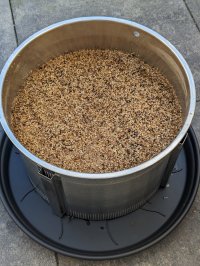I've noticed discussion threads for various electric brewing systems such as the Brewzilla, SS Brewtech SVBS, etc. Since I just bought a Grainfather G40 for Christmas, I thought I would start a thread for the G40 and G70. To start it out, I have the following thoughts/observations:
- I bought a 55 barrel drum cart for my G40 which makes it easy to wheel in and out of the garage and wherever I need it. Amazon.com
- I replaced the plug at the bottom of the sight glass with a small ball valve which makes draining the G40 much easier. Amazon.com I also added a male camlock fitting and have an 8' silicon hose with a female camlock fitting. I have no problem pumping the wort through the bottom ball valve, through the hose and into my conical fermenters which are on a table approximately 3' off the ground. No more lifting heavy conicals!
- I love the delayed heat feature. I filled the G40 with my strike water the night before brew day and set the timer for a half hour before I woke up, so I could just get out of bed and dough in without having to wait. I love the fact that, unlike my prior propane set up, I can have it warm the water up while still in my closed garage and then wheel it out onto the driveway for the dough in and eventual boil. Recently, I planned to brew, but had to do some errands in the morning first. I filled the GF with my strike water, plugged it in and okayed remote access. Then, about half hour before I expected to get home, I turned on the heat from afar. How cool is that!
- I have learned from experience that water and grain will overflow the basket through the handle holes if you use too much strike water or have a grain bed that does not drain very well while recirculating. This happened when I tried to use more than 8 1/2 gallons of strike water and again with a Mexican Lager batch which had a ton of flaked corn. I now understand why there is talk of selling a grain basket top plate as an accessory.




